Top speed 338 km/h Length 12 m Engine type Reciprocating engine | Wingspan 15 m Introduced 1943 First flight December 7, 1940 | |
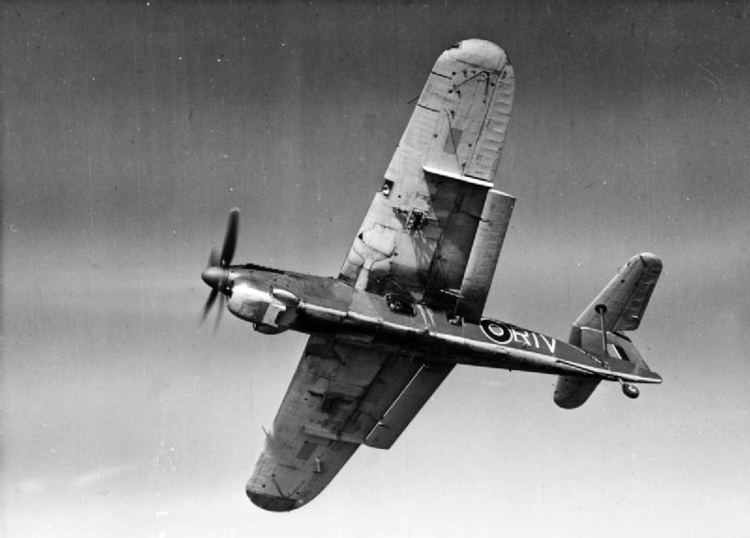 | ||
Manufacturers Blackburn Aircraft, Avions Fairey, Westland Aircraft, Boulton Paul Aircraft | ||
British fairey barracuda dive bomber 1944
The Fairey Barracuda was a British carrier-borne torpedo and dive bomber used during the Second World War, the first of its type used by the Royal Navy's Fleet Air Arm to be fabricated entirely from metal. It was introduced as a replacement for the Fairey Swordfish and Fairey Albacore biplanes. It is notable for its role in attacking the German battleship Tirpitz, and known for its ungainly appearance on the ground.
Contents
- British fairey barracuda dive bomber 1944
- Airplane ww2 raf fairey barracuda ww2 raf aeroplano fairey barracuda
- Design and development
- British service
- Canadian service
- Surviving aircraft
- Variants
- Operators
- Specifications Barracuda Mk II
- References

Airplane ww2 raf fairey barracuda ww2 raf aeroplano fairey barracuda
Design and development
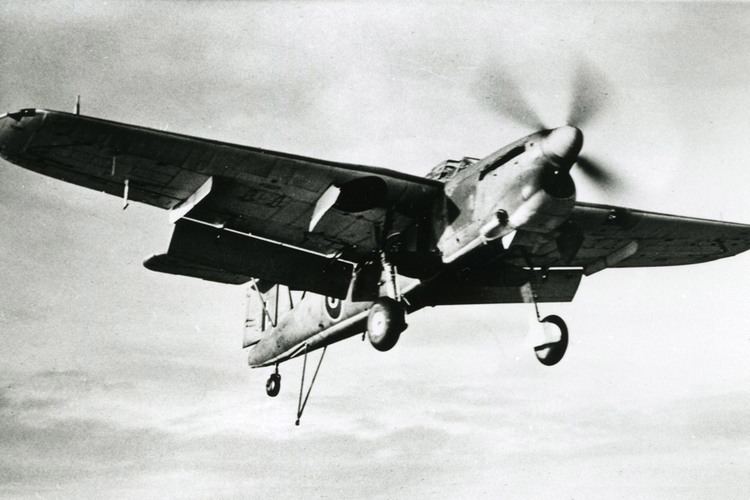
The Barracuda resulted from Air Ministry Specification S.24/37 issued in 1937 for a monoplane torpedo bomber to meet Operational Requirement OR.35. Of the six submissions, the designs of Fairey Aviation and Supermarine (Type 322) were selected and two prototypes of each ordered. The first Fairey prototype flew on 7 December 1940. The Supermarine Type 322 first flew in 1943 but with the Barracuda already in production it did not progress further.
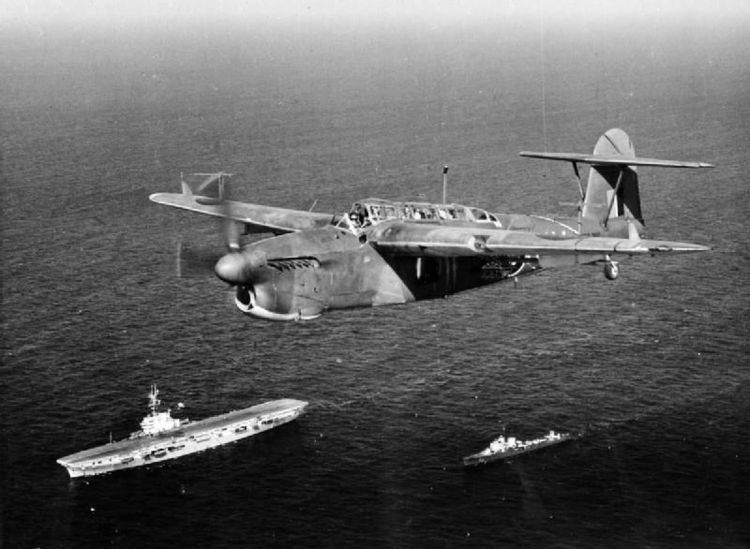
The Barracuda was a shoulder-wing cantilever monoplane with an oval, all-metal fuselage. It had a retractable landing gear and non-retracting tailwheel. The hydraulically-operated main landing gear struts were of an "L" shape and retracted into a recess in the side of the fuselage, with the wheels held in the wing. A flush arrestor hook was fitted ahead of the tail wheel. The crew of three were in tandem under a continuous glazed canopy. The pilot had a sliding canopy and the other two crew members' canopy was hinged. The two rear-crew had alternate locations in the fuselage, with the navigator having bay windows below the wings for downward visibility. The wings had large Fairey-Youngman flaps that doubled as dive brakes. Originally fitted with a conventional tail, flight tests suggested stability would be improved by mounting the stabiliser higher, similar to a T-tail, which was implemented on the second prototype. For carrier stowage, the wings folded back horizontally at the roots; the peculiar small vertical protrusions on the upper wingtips held hooks that attached to the horizontal stabilizers.
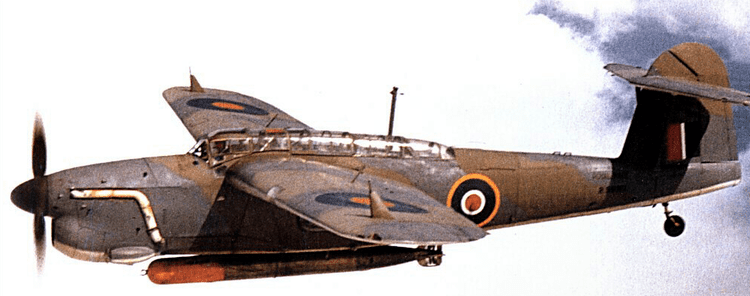
The Barracuda was originally intended to use the Rolls-Royce Exe X block, sleeve valve engine, but production of this powerplant was abandoned, which delayed the prototype's trials. The prototypes eventually flew with the lower-powered 12-cylinder Vee type Rolls-Royce Merlin 30 engine (1,260 hp/940 kW) and a three-bladed de Havilland propeller. Further experience with the prototypes and the first production machines (Barracuda Mk I) revealed the aircraft to be underpowered as a result of the weight of extra equipment that had been added since the initial design. Only 30 Mk Is were built (including five by Westland Aircraft), and used only for trials and conversion training. Replacing the Merlin 30 with the more powerful Merlin 32 (1,640 hp/1,225 kW) and a four-bladed propeller resulted in the definitive Barracuda Mk II variant of which 1,688 were manufactured; by Fairey (at Stockport and Ringway) (675), Blackburn Aircraft (700), Boulton Paul (300), and Westland (13). The Mk II carried metric wavelength ASV II (Air to Surface Vessel) radar, with the Yagi-Uda antennae carried above the wings.
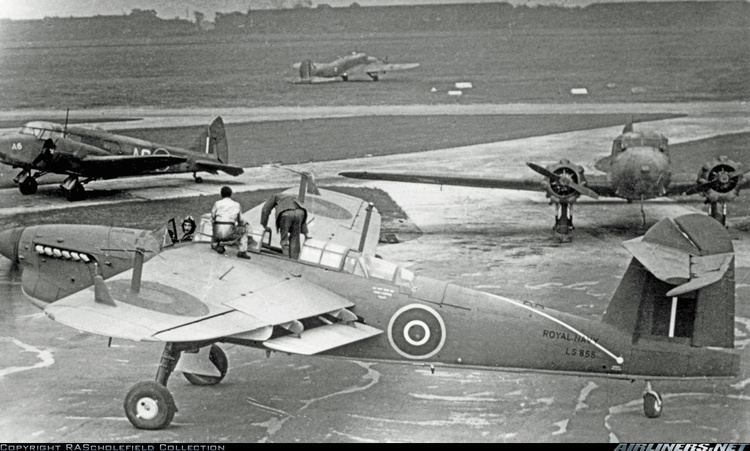
The Barracuda Mk III was the Mk II optimised for anti-submarine work, with the metric wavelength ASV set replaced by a centimetric variant, the scanner for which was housed in a blister under the rear fuselage. 852 Mk IIIs were eventually produced (406 by Fairey, 392 by Boulton Paul). A total of 2,607 of all marks of Barracuda were built.
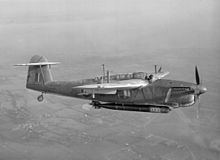
The Barracuda Mk IV never left the drawing board; the next and final variant was the Barracuda Mk V, in which the Merlin powerplant was replaced with the Rolls-Royce Griffon. The increased power and torque of the Griffon required various aerodynamic changes; the vertical stabiliser was enlarged and the wing span was increased with the tips clipped. The Mk V, converted from a Mk II, did not take to the air until 16 November 1944, and Fairey built only 37 before the war in Europe was over.
Early Merlin 30-powered Mk 1 Barracudas were underpowered and suffered from a poor rate of climb. Once airborne, however, the type proved easy to fly. Trials of the Mk 1 at Boscombe Down in October 1941 showed a weight of 12,820 lb (5,830 kg) when equipped with 1,566 lb (712 kg) torpedo; at this weight the Mk 1 showed a maximum speed of 251 mph (405 km/h) at 10,900 ft (3322 m), a climb to 15,000 ft (4572 m) took 19.5 minutes, with a maximum climb rate of 925 fpm (4.7 m/s)at 8,400 ft (2,560 m), and a 19,100 ft (5,822 m) service ceiling.
The later Mk II had a more powerful Merlin 32 with a 400 hp (300 kW) increase in power. Boscombe Down testing of the Mk II in late 1942, at 14,250 lb (6,477 kg) showed a climb to 10,000 ft (3048 m) in 13.6 minutes, with a maximum climb rate of 840 fpm (4.3 m/s) at 5,200 ft and an effective ceiling of 15,000 ft (4,572 m). Further testing at Boscombe Down in June 1943, showed a maximum range, with either a 1,630 lb (750 kg) torpedo or a single 2,000 lb bomb (909 kg), of 840 statute miles (1,355 km), and a practical range of 650 statute miles (1,048 km), while carrying 6 x 250 lb (114 kg) bombs reduced the range to 780 miles (1,258 km) and 625 miles (1,008 km), respectively.
Pilots came to appreciate the powerful flaps / airbrakes; carrier landings were simple due to the flaps and good visibility from the cockpit. Retracting the airbrakes at high speeds, whilst simultaneously applying rudder caused a sudden change in trim which could throw the aircraft into an inverted dive. This proved fatal on at least five occasions during practice torpedo runs, but the problem was identified, and appropriate pilot instructions issued, before the aircraft entered carrier service.
During the earlier part of its service life, the Barracuda suffered a fairly high rate of unexplained fatal crashes, often involving experienced pilots. In 1945 this was traced to small leaks developing in the hydraulic system. The most common point for the leak was at the point of entry to the pilot's pressure gauge and was situated such that the resulting spray went straight into the pilot's face. The chosen hydraulic fluid contained ether and as the aircraft rarely were equipped with oxygen masks (and few aircrew wore them below 10,000 ft/3,000 m anyway) the pilot quickly became unconscious leading to a crash. An Admiralty order issued at the end of May 1945 required all examples of the type to be fitted with oxygen as soon as possible, and for pilots to use the system at all times.
British service
The first Barracudas entered service on 10 January 1943 with 827 Squadron and were deployed in the North Atlantic. A total of 24 front-line squadrons were eventually equipped with Barracudas. From 1944 onwards, the Mk IIs were accompanied in service by radar-equipped, but otherwise similar, Mk IIIs, which were used for anti-submarine work.
The Barracuda first saw action with 810 Squadron aboard HMS Illustrious off the coast of Norway in July 1943 before deploying to the Mediterranean to support the Salerno landings. The following year they entered service in the Pacific Theatre.
The Royal Air Force used the Barracuda Mk II, initially in 1943 with No. 567 Sqn. at RAF Detling. In 1944, similar models went to 667 Sqn. (RAF Gosport), 679 Sqn. (RAF Ipswich) and 691 Sqn. (RAF Roborough). All the aircraft were withdrawn between March and July 1945.
Barracudas were used as dive bombers and played a part in a major attack on the German battleship Tirpitz. On 3 April 1944 (Operation Tungsten), 42 aircraft from British carriers HMS Victorious and Furious scored 14 direct hits on Tirpitz with 1,600 lb (730 kg) and 500 lb (230 kg) bombs at the cost of one bomber. The attack disabled Tirpitz for over two months. However, the slow speed of the Barracudas contributed to the failure of the Operation Mascot and Operation Goodwood attacks on Tirpitz during July and August.
From April 1944, Barracudas of No 827 Squadron aboard Illustrious started operations against Japanese forces, taking part in raids against Sabang in Sumatra (Operation Cockpit). The Barracuda's performance was reduced by the high temperatures of the Pacific, with its combat radius being reduced by as much as 30%, and the torpedo bomber squadrons of the fleet carriers of the British Pacific Fleet were re-equipped with Grumman Avengers.
The Barracuda's primary problem in the Pacific was the need to fly over Indonesian mountain ranges to strike at targets on the eastern side of Java, which necessitated a high-altitude performance that the Barracuda's low-altitude-rated Merlin 32 engine with single stage supercharger could not provide. Additionally, carrying maximum underwing bomb loads caused extra drag which further reduced performance over a Barracuda armed with a torpedo. However the Light Fleet Carriers of the 11th ACS which joined the BPF in June 1945 were all equipped with a single Barracuda and single Corsair squadron, so by VJ day the BPF had five Avenger and four Barracuda squadrons embarked on its carriers.
Barracudas were used to test several innovations including RATOG rockets for takeoff and a braking propeller which slowed the aircraft by reversing the blade pitch.
The Barracuda continued in Fleet Air Arm service until the mid-1950s, by which time they were all replaced by Avengers.
Canadian service
The Royal Canadian Navy took delivery on 24 January 1946 of 12 radar-equipped Mk II aircraft; this was a Canadian designation, in British service these were the Mk. III. The first acquired aircraft were assigned to the newly formed 825 Sqn. aboard aircraft carrier HMCS Warrior. Canadian aircraft mechanics had been trained in the UK during the war serving on British aircraft carriers, notably HMS Puncher and Nabob which along with some Canadian pilots, the RCN crewed and operated for the RN. Warrior paid off in 1948 and returned to Britain along with the Barracuda aircraft.
Surviving aircraft
Over 2500 Barracudas were delivered to the Fleet Air Arm, more than any other type ordered by the Royal Navy at that date. Unlike other aircraft of its era, none were retained for posterity and no complete examples exist today. Since the early 1970s the Fleet Air Arm Museum has been collecting Barracuda components from a wide variety of sources throughout the British Isles, with the long-term aim of rebuilding an example. In 2010 help was sought from the team rebuilding Donald Campbell's speed boat, Bluebird, as the processes and skills involved were related to those needed to recreating the aircraft from the crashed remains, so between May 2013 and February 2015 'The Barracuda Project' operated as a sister project to the Bluebird rebuild. During this time the entire tail section of LS931 was successfully reconstructed using only original material. In September 2014 wreckage of an entire rear fuselage was delivered to the workshops to undergo the same processes. In February 2015 the Barracuda sections were sent back to the Fleet Air Arm Museum, where the work now continues.
Variants
Operators
Specifications (Barracuda Mk II)
Data from Fairey Aircraft since 1915
General characteristics
Performance
Armament
